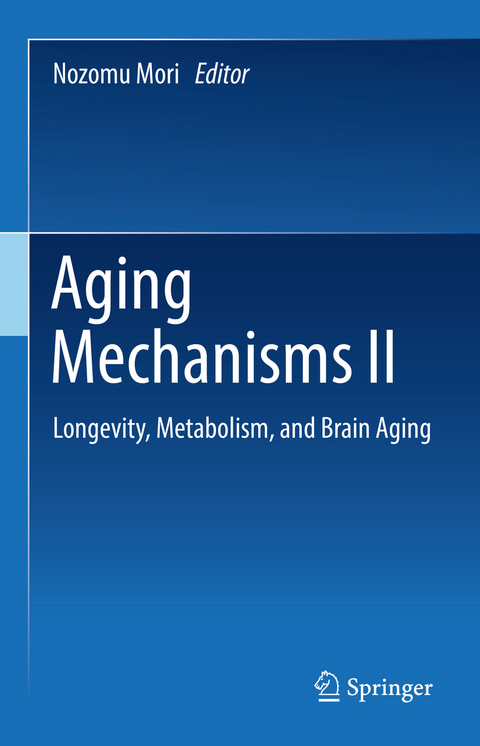
Aging Mechanisms II
Springer Verlag, Singapore
978-981-16-7976-6 (ISBN)
Chapter contributors are selected based on recent scientific achievements on the mechanisms of aging in various model organisms, including yeast, worm (C. elegans), fly (Drosophila), mice, and rats. Chapters are ordered from the discussion on molecular and cellular levels to physiological and systemic levels. The book also provides an overview of aging science in the region and helps readers quickly grasp who is doing what in this research area.
As the aging of population becomes an ever more pressing issue in Asia, advancing the understanding of basic mechanisms of organism aging and longevity determination will be crucial to developing more effective therapies and protective strategies. Researchers and graduate students in biomedical aging research will find this as a rich source of information and a stimulus to novel research directions.
Nozomu Mori, Ph.D. graduated University of Tokyo, Faculty of Pharmaceutical Sciences, and obtained Ph.D. at the same school. His current position is Professor at Fukuoka International University of Health and Welfre, Faculty of Medicine, and Professor Emeritus of Nagasaki University. He was in the board member at Japan Gerontological Society and also at Japan Society of Biomedical Gerontology. Dr. Mori's scientific experties includes molecular cellular biology, neurobiology, and aging science. Dr. Mori previously directed laboratories at Andrus Gerontology Center at University of Southern California (USC) (1989-1995), JST-PREST (Sakigake) at Keihanna Plaza (1995-1997), Departmen of Molecuar Genetics at National Institute of Longevity Science (NILS) (1997-2004), JST-CREST at NILS (1997-2002), and Department of Anatomy and Neurobiology at Nagasaki University School of Medicine (2004-2019). He also served as University Library Director at Nagaski University (2013-2015) and also in its Medical Branch (2009-2013). Dr. Mori is the founding organizer of international discussion forum on aging between Japan and Korea named Asian Aging Core for Longevity (AACL), which was supported by JSPS during 2010-2015. AACL is currently further developed as Asian Society for Aging Research (ASAR) among the East Asian nations incuding China, Hong Kong, and Taiwan.
Chapter 1. An Unsolved Problem in Gerontology Yet : The Molecular Mechanism of Biological Aging – A Historical and Critical Overview.- Chapter 2. Clinical and Basic Biology of Werner Syndrome, the Model Disease of Human Aging .- Chapter 3. Biomarkers of Healthy Longevity: Lessons from Supercentenarians in Japan.- Chapter 4. Cellular aging and metabolites in aging.- Chapter 5. To G0 or Not to G0: Cell Cycle Paradox in Senescence and Brain Aging.- Chapter 6. C. elegans longevity genes.- Chapter 7. Understanding the functions of longevity genes in Drosophila.- Chapter 8. NAD+ metabolism in Aging.- Chapter 9. Mitochondrial dysfunction and growth differentiation factor 15 in aging.- Chapter 10. Sirtuins and metabolic health.- Chapter 11. Autophagy in aging and longevity.- Chapter 12. Sarcopenia: current topics and future perspective.- Chapter 13. Osteoporosis and cellular senescence in bone.- Chapter 14. Aging and chronic kidney disease viewed from the FGF-Klotho endocrine system.- Chapter 15. Aging biomarker SMP30 into a new phase of vitamin C and aging research.- Chapter 16. Age-related memory impairments are caused by alterations in glial activity at old ages.- Chapter 17. Critical Roles of Glial Neuroinflammation in Age-Related Memory Decline.- Chapter 18. Central mechanisms linking age-associated physiological changes to healthspan through the hypothalamus.- Chapter 19. PET imaging of amyloid and tau in Alzheimer’s disease.- Chapter 20. Presenilin/γ-secretase in the pathogenesis of Alzheimer disease.- Chapter 21. Amyloid-β in brain aging and Alzheimer’s disease.- Chapter 22. Tau Pathology and Neurodegenerative Disorders.- Chapter 23. Aging and Parkinson’s disease: pathological insight on model mice.- Chapter 24. Evaluating the brain aging through eyes: The Potential use of hyperspectral imaging cameras to diagnose Alzheimer's disease risk.- Chapter 25. Healthy Aging in Japan.
| Erscheinungsdatum | 04.05.2022 |
|---|---|
| Zusatzinfo | 1 Illustrations, black and white; XVIII, 430 p. 1 illus. |
| Verlagsort | Singapore |
| Sprache | englisch |
| Maße | 155 x 235 mm |
| Gewicht | 834 g |
| Themenwelt | Medizin / Pharmazie ► Medizinische Fachgebiete ► Geriatrie |
| Studium ► 1. Studienabschnitt (Vorklinik) ► Physiologie | |
| Naturwissenschaften ► Biologie ► Humanbiologie | |
| Naturwissenschaften ► Biologie ► Zoologie | |
| Schlagworte | Aging, longevity • Biogerontology • Geriatrics • Neurodegeneration • Neuroscience |
| ISBN-10 | 981-16-7976-2 / 9811679762 |
| ISBN-13 | 978-981-16-7976-6 / 9789811679766 |
| Zustand | Neuware |
| Haben Sie eine Frage zum Produkt? |
aus dem Bereich


